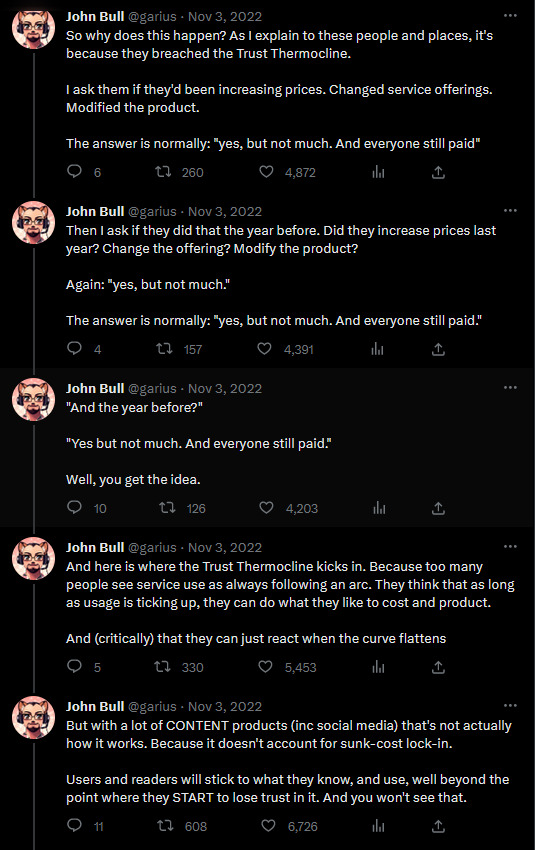#Customer Trust
Explore tagged Tumblr posts
Text
The Currency of Trust: Building a Business on Honor and Integrity
Building trust and honor in business isn’t just good ethics—it’s smart strategy. Discover how it impacts sales, marketing, and customer loyalty! Dive into the latest blog to learn more. #CustomerLoyalty #TrustInBusiness #MarketingWithIntegrity
Trust is the currency of business The Currency of Trust: Building a Business on Honor and Integrity Written By that Hannah Jones Read Time 4 minutes Trust is the bedrock of any successful business. In a marketplace crowded with endless options, trust becomes the defining factor that not only drives sales but also cultivates loyalty and builds a brand’s reputation. But trust doesn’t just…
#authentic marketing#brand credibility#brand integrity#brand loyalty#brand loyalty tips#brand trust#building trust#business ethics#Business Growth#business honor#business reputation#consumer trust#customer engagement#customer loyalty#customer trust#ethical branding#ethical marketing#ethical sales#marketing strategies#marketing with integrity#relationship marketing#responsible business#sales authenticity#sales growth#sales strategies#transparent business practices#trust and sales#trust in business#trust-building strategies#trustworthy brand
3 notes
·
View notes
Photo
I need everyone to understand that the trust thermocline is not a thing. This is just one guy on Twitter posting about those without any examples. It doesn’t really make a whole lot of sense. It can only make sense in specific situations with like a fast food chain that is shitty and goes bankrupt and doesn’t resurrect itself. I think this is an Astroturf intellectual idea. Anyone on the Internet talking about it only ends up referring to this One tweet thread from one guy. I don’t really think this concept is actually anything, honestly. Here’s a full length article that the same guy wrote that I have been intending to read that may end up, changing someone’s mind one way or the other. 




Really good Twitter thread originally about Elon Musk and Twitter, but also applies to Netflix and a lot of other corporations.
Full thread. Text transcription under cut.
Keep reading
63K notes
·
View notes
Text
Struggling with low or few reviews on your business profile?
Poor online reputation can seriously hurt trust and turn potential customers away.
I help businesses boost their reputation by:
• Getting more genuine 5-star reviews
• Managing or responding to negative feedback
• Setting up automated review requests to keep things consistent
Want a quick audit or a short chat to see how this can help your business grow?
Let’s connect!
1 note
·
View note
Text

Today, privacy laws are the regulations that must be followed. An organisation failing to comply with privacy regulations on consent management will face the following consequences:
Large fines for not following the rules.
Loss of user trust due to imprecise or disturbing data practices.
Messy operational working with consent based on different jurisdictions.
The CMP is not just a regulatory box-ticking exercise; it is becoming increasingly vital for business survival. These are the reasons your businesses need a cmp.
#PrivacyLaws#DataProtection#GDPR#CCPA#ConsentManagement#UserTrust#ComplianceMatters#BusinessEthics#DataPrivacy#RegulatoryCompliance#seersai#businesscompliance#cookieconsent#financial protection#customer trust
0 notes
Text

The Role of Bill of Lading in Optimizing E-Commerce Conversion Rates
Learn how optimizing the Bill of Lading can improve conversion rates and customer satisfaction in e-commerce.
Source: https://cro.media/insights/strategies/bill-of-lading-ecommerce-conversion-optimization/
The Bill of Lading (BOL) is a critical document in the shipping process, often viewed as the backbone of logistics and freight management. However, its indirect impact on Conversion Rate Optimization (CRO) is an aspect that is not often discussed but holds significant potential for online businesses. At cro.media, we recognize that optimizing the customer journey involves not only improving the user experience on digital platforms but also ensuring that backend processes, like logistics and order fulfillment, align with customer expectations. Here, we’ll explore how understanding and optimizing the BOL process can enhance conversion rates and customer satisfaction.
"A well-managed Bill of Lading process helps minimize errors by ensuring all shipping details are documented clearly and correctly."
Trust and Clarity in the Shipping Process
A BOL establishes a clear agreement between the shipper and carrier, providing a guarantee of delivery, which directly impacts the reliability of the shipping experience. When customers feel confident that their purchases are being handled securely and tracked properly, it reduces hesitation in making a purchase. In e-commerce, where customers often abandon carts due to unclear shipping policies or doubts about delivery, a transparent shipping process—with clear documentation such as the BOL—can reduce friction, resulting in higher conversion rates.
For e-commerce sites, displaying shipping and delivery details transparently, potentially linked with real-time updates based on the BOL, could improve user experience and customer trust, leading to fewer abandoned carts.
Streamlined User Experience and Reduced Friction
The details provided on the BOL, such as the shipment's content, weight, value, and packaging, play a significant role in preventing errors during the shipping process. For e-commerce platforms, integrating this data directly into the order management system and providing customers with automated notifications about their shipments can improve the user experience. This reduces potential delays or issues related to lost or incorrect shipments, thus leading to fewer customer complaints and, ultimately, higher customer satisfaction.
Negotiability and Flexibility
In cases where an Order Bill of Lading is used, the negotiability feature allows for greater flexibility in shipping agreements. If an order is shipped before full payment is received, the recipient can endorse the BOL to transfer the title, creating a financial instrument. For online businesses, integrating such flexible payment and shipping arrangements can be a powerful tool to enhance sales, especially for B2B e-commerce platforms where invoicing and payment terms play a pivotal role. Offering flexible options can drive conversion by addressing financial concerns, which can be a barrier to completing a purchase.
Enhancing Transparency with Shipment Tracking
Many customers abandon purchases due to unclear expectations around delivery. Providing access to BOL-based tracking information can help mitigate this. By integrating detailed shipment tracking features that reflect the BOL, e-commerce platforms can offer customers more control and visibility throughout the shipping process. This added transparency can significantly improve conversion rates, as customers are more likely to trust and finalize purchases when they feel confident about their delivery timelines.
Reducing Errors and Enhancing Operational Efficiency
In e-commerce, operational errors related to order fulfillment, inventory discrepancies, and incorrect shipments can lead to costly delays and poor customer experiences. A well-managed Bill of Lading process helps minimize such errors by ensuring all shipping details are documented clearly and correctly. Automating this process with integrated systems can improve accuracy and efficiency, which, in turn, can reduce order fulfillment time, improve customer satisfaction, and enhance conversion rates. Less time spent on correcting mistakes means more time focusing on acquiring and converting new customers.
The Importance of Detailed Shipping Information in Customer Decision-Making
The data captured on a Bill of Lading—such as the description of the goods, the value, and the nature of packaging—can directly influence the customer’s decision to make a purchase. E-commerce platforms that provide accurate and detailed product descriptions, aligned with shipment documentation, create a seamless and trustworthy shopping experience. This integration not only reduces cart abandonment but also builds brand loyalty, as customers are more likely to return when they can trust the shipping and handling process.
"By integrating the functionality and transparency of the Bill of Lading process into the customer journey, e-commerce businesses can improve their operational efficiency and user experience."
Conclusion
By integrating the functionality and transparency of the Bill of Lading process into the customer journey, e-commerce businesses can improve their operational efficiency and user experience, which are critical factors in Conversion Rate Optimization. From building trust with transparent shipping information to reducing operational errors and offering flexible payment options, the strategic use of BOL in the e-commerce landscape can significantly enhance conversion rates, customer satisfaction, and overall business performance.
0 notes
Link
Building an online store is easier than ever, thanks to a variety of ecommerce platforms that require zero coding skills. Whether you're eyeing Shopify for its simplicity, Magento for its flexibility, or the fresh vibes of Solana Pay, there's something for everyone in 2024.
But remember, a successful site isn't just about choosing a platform. Consistency in design, mobile responsiveness, and building trust with features like clear contact info and customer reviews are key to creating a memorable shopping experience. High-quality visuals and user-friendly navigation will keep your customers engaged and eager to hit "buy."
Check out examples of standout ecommerce sites that showcase these elements and get inspired to bring your vision to life! The online marketplace is yours for the taking.
#ecommerce#online business#Shopify#Magento#Solana Pay#web design#mobile responsive#customer experience#online store tips#digital marketing#business success#entrepreneurship#user experience#web development#online shopping#branding#customer trust#visual marketing#website design#retail trends
0 notes
Text
Why User Experience (UX) Is the Secret Key for E-Commerce Success

In today’s digital marketplace, user experience (UX) can make or break your e-commerce business. A seamless, intuitive, and visually appealing website not only enhances customer satisfaction but also builds trust—an essential factor in driving conversions.
First Impressions Matter
When users land on your website, they immediately assess its credibility. A poorly designed site with slow loading times, clunky navigation, or confusing layouts can lead to high bounce rates and lost sales. On the other hand, a well-structured and visually appealing website encourages visitors to explore further.
Navigation and Simplicity
A cluttered website overwhelms users, making it difficult to find products or complete purchases. Clear menus, intuitive search functions, and straightforward checkout processes improve the shopping experience, reducing cart abandonment rates.
Mobile Optimisation: A Non-Negotiable Factor
With mobile commerce on the rise, an e-commerce website must be fully responsive. A mobile-friendly site ensures that users can browse and purchase products effortlessly, no matter the device they’re using. If your website isn’t optimised for mobile, you risk losing a significant portion of potential customers.
Speed and Performance Drive Trust
Customers expect fast-loading pages. Research shows that a one-second delay in page load time can decrease conversions by 7%. Optimising your site’s speed improves engagement and reinforces trust, as slow websites are often associated with security concerns.
Enhance UX, Build Trust, and Boost Sales
Investing in user experience is not just about aesthetics—it’s about creating a seamless journey that builds confidence in your brand. By improving navigation, speed, and mobile usability, you can establish trust and encourage repeat customers.
For more insights on how trust impacts e-commerce success, read the full article to know more.
0 notes
Text
How to Build Customer Trust and Brand Value in B2B Marketing
In the competitive world of B2B marketing, establishing brand value is paramount. Customers today seek more than just a product or service; they look for trust, authenticity, and reliability. Building customer trust through strong brand value not only sets you apart but also establishes lasting brand equity. This guide will explore actionable strategies to enhance your B2B marketing efforts by focusing on trust and value.
What is Brand Value in B2B Marketing?
Brand value goes beyond a logo or tagline—it’s the emotional and functional connection your business creates with its customers. In B2B marketing, brand value reflects how your business helps clients solve their challenges, achieve their goals, and succeed in their industries.
Get full insights@ https://itechseries.com/blog/brand-value/
When your brand value is clear, it fosters trust. Businesses feel confident choosing your product or service, knowing it aligns with their needs and values. This trust directly impacts brand equity, elevating your position in the market.
Why Trust is Central to Brand Equity
In B2B transactions, trust is non-negotiable. Decisions often involve higher stakes, longer buying cycles, and larger budgets than in B2C scenarios. Thus, trust directly influences purchasing decisions and long-term partnerships.

A business with strong brand equity commands credibility and loyalty. When customers trust your brand, they’re more likely to return, advocate for your services, and refer others, all of which amplify your market presence.
Understand Your Audience to Build Trust
The foundation of any successful marketing strategy is a deep understanding of your audience. To foster trust, you must know your customer’s pain points, goals, and preferences.
Start by creating detailed buyer personas. These personas should outline customer demographics, challenges, and decision-making criteria. Then, use these insights to tailor your messaging and offerings to their specific needs, reinforcing your brand value.
Leverage Thought Leadership to Enhance Brand Value
Thought leadership is a powerful way to build trust in B2B marketing. When your brand consistently delivers valuable insights, it positions you as an expert in your industry.
Publish whitepapers, blogs, and case studies that address your customers’ challenges. Participate in webinars, podcasts, or industry events to showcase your expertise. This approach not only educates your audience but also strengthens your brand equity.
Consistency in Messaging Builds Credibility
Consistency in messaging is a hallmark of trust. Customers need to see that your brand’s values and promises remain steadfast across all platforms and interactions.Develop a clear brand voice and ensure that your messaging aligns with your core values, whether through social media, email campaigns, or sales calls. Over time, this consistency builds a reputation for reliability and professionalism.
Explore the latest marketing and tech insights@ https://itechseries.com/gtm-library/
Transparency Enhances Customer Relationships
Transparency is essential in today’s marketing landscape. B2B customers value honesty about your product’s capabilities, pricing, and limitations. Misleading claims or hidden fees can erode trust and damage brand equity.
Be upfront about what your product or service can deliver. Share customer testimonials, case studies, and data-driven results to back up your claims. Transparency fosters trust and demonstrates your commitment to customer success.
Invest in Customer Experience for Lasting Loyalty
A positive customer experience (CX) is directly tied to brand value. Every interaction, from initial inquiries to post-sale support, shapes how customers perceive your brand.
Prioritize responsiveness, personalization, and proactive problem-solving in your CX strategy. When customers feel valued and supported, they’re more likely to trust your brand and remain loyal, which enhances your brand equity.
Social Proof: The Power of Customer Advocacy
In B2B marketing, peer recommendations carry significant weight. Social proof, such as reviews, testimonials, and case studies, helps validate your brand’s credibility. Encourage satisfied clients to share their success stories. Highlight these testimonials on your website, in marketing materials, and during sales pitches. Seeing real-world results reassures potential customers that your brand delivers on its promises.
How to Measure and Improve Brand Value
Building brand value is an ongoing process. Use metrics such as customer retention rates, Net Promoter Score (NPS), and brand recall surveys to assess your progress.
Continuously gather feedback from customers to identify areas for improvement. By addressing gaps and refining your marketing strategy, you’ll strengthen trust and boost your brand equity over time.
Conclusion
Building customer trust is the cornerstone of establishing strong brand value in B2B marketing. By understanding your audience, being consistent in your messaging, and investing in customer experience, you can create lasting brand equity. Incorporate transparency, thought leadership, and social proof into your marketing strategy to solidify trust and drive long-term growth.
Remember, trust takes time to build but only moments to lose. Focus on delivering value and reliability at every step, and your brand will stand out in the competitive B2B landscape.
#Brand Value#B2B Marketing#Customer Trust#Brand Equity#Marketing Strategy#B2B Growth#Brand Valuation#Customer Loyalty#Digital Marketing#Thought Leadership
0 notes
Text
Tejinder Singh Bhatia Yellowstone Landmark Infocity Panchkula, advice for building customer trust
Building customer trust is crucial for long-term success. Tejinder Singh Bhatia stresses the importance of delivering consistent value, being transparent, and engaging with customers regularly to nurture trust and loyalty.
Business Tips By Tejinder Singh Bhatia Yellowstone Landmark Infocity Panchkula:
Provide high-quality products and services consistently.
Be transparent about pricing, policies, and product features.
Communicate regularly with customers to understand their needs.
Offer guarantees or warranties to assure product quality.
Implement a robust customer support system.
Encourage customer reviews and feedback to build credibility.
Address issues promptly to demonstrate your commitment to customer satisfaction.
Show appreciation for your customers through personalized gestures.
Share your company’s values and mission to resonate with customers.
Build a strong online presence to reinforce trust.
In conclusion, Tejinder Singh Bhatia Yellowstone Landmark Infocity Panchkula emphasizes that trust is the foundation of customer loyalty, and businesses must focus on consistency, transparency, and engagement.
#Tejinder Singh Bhatia Yellowstone Landmark Infocity Panchkula#customer trust#building brand trust#transparent business practices#customer engagement#customer support#high-quality products#customer loyalty#online presence#customer feedback
0 notes
Text
ORM Strategies Unstoppable Growth
Discover how ORM (Online Reputation Management) strategies can drive unstoppable growth for your business. By managing your brand's online presence, addressing feedback, and fostering positive reviews, you build trust and credibility. These strategies not only protect your brand but also boost customer engagement and loyalty, ensuring long-term success.
0 notes
Text
Data privacy has become a defining issue in digital advertising, as consumers grow more aware of how their information is collected and used. With stricter regulations like the GDPR in Europe and CCPA in the U.S., advertisers need to rethink their approach to handling consumer data. This shift has created both challenges and opportunities for brands.
One major change is the gradual elimination of third-party cookies, which have long been used to track user behavior and serve personalized ads. As browsers like Chrome and Safari phase them out, companies must now rely on first-party data – information collected directly from their own users. This means building stronger relationships with customers through newsletters, apps, and other channels where users voluntarily share their data.
At the same time, consumers still expect personalized experiences, but they want more control over their data. This is where transparency and trust come into play. Brands that are upfront about their data policies and give users options, such as the ability to opt out of data collection, are more likely to earn loyalty and stand out in a competitive market.
With hyper-targeted advertising becoming more difficult, marketers are also exploring alternative methods. Contextual advertising, where ads are displayed based on the content being consumed rather than personal data, is making a resurgence. This allows brands to reach relevant audiences without compromising privacy.
In this new environment, the brands that succeed will be those that balance effective advertising with respect for consumer privacy. Transparency, ethical data usage, and creative, non-intrusive marketing strategies will be key.
If you're looking to stay ahead of the curve, it's essential to gain up-to-date knowledge in digital marketing. Vidya Sarthi Institute of Digital Marketing offers a best digital marketing course in south delhi with a one-week free trial. It’s a great opportunity to learn the latest techniques and strategies while mastering the balance between impactful marketing and data privacy.
0 notes
Text
How Branding Can Make or Break Your Startup
Branding is a powerful tool that can either elevate your startup or hinder its growth. A well-defined brand communicates your values, mission, and promises to your audience, creating loyalty and trust.
0 notes
Text
Fireside Chat with Laura Fernández: The Intersection of Sales and Localization Operations
Introduction In the latest episode #67 of the Localization Fireside Chat, hosted by Robin Ayoub, we had the pleasure of interviewing Laura Fernandez, Chief Sales Officer at Supertext. This episode, #67, dives into the crucial interplay between sales and operations within the localization industry. Laura shares her unique insights and experiences, emphasizing the importance of communication and…

View On WordPress
#Accountability#Communication#Customer Trust#language services#Laura Fernandez#Localization#Sales and Operations#Supertext
0 notes
Text
#brand crisis communication#brand crisis management#crisis communication plan#crisis management#public relations crisis#brand reputation#controversy#customer trust#proactive communication#public relations#pr agency in noida#best pr agency in india#pr agency#best pr agencies in india#pr agency for startups in india#pr agencies in noida#best pr agencies in noida#pr
1 note
·
View note